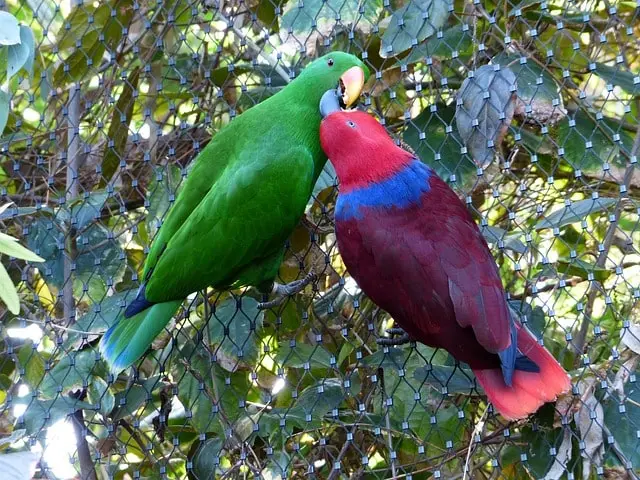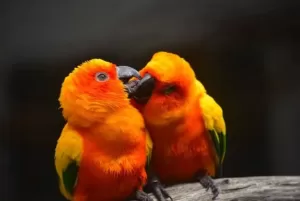Parrots are socially monogamous, often remaining with the same mate for one or several mating seasons. They are highly social birds known to form strong bonds with their mates. Kissing and other mating rituals serve to strengthen the pair bond between them.
While parrots do not trade kisses like humans, they have their own unique way of showing affection to their mates. Kissing is a display of love, but it is also a method to determine compatibility between the two parrots.
Parrots kiss by touching or grasping each other’s beaks. This involves the two birds locking their beaks crosswise accompanied by slow head bobbing. Some species of parrots even use their tongues while kissing imitating the French kiss.
Quick Navigation
How Do Parrots Kiss
Parrots don’t kiss in the traditional sense. They touch and stroke their beaks, which is often followed by allofeeding. Allofeeding is a courtship behavior where one parrot feeds the other by regurgitating food into their mouth. This is a way for them to show affection towards each other and express their readiness to mate.
In an article by Ornithology Research, researchers observed kissing behavior and allofeeding in a pair of Rainbow Lorikeets. The parrots drank water accumulated in a mangrove branch hole, and following this, the male engaged in preening the female’s nape.
Subsequently, the pair interlocked their beaks and bobbed their heads slightly. During the kiss, there was a liquid transfer observed, as evidenced by the female having a liquid over her tongue, including the brush tip.
In this interaction, only liquid transfer was observed, with no food particles. Given that Rainbow Lorikeets predominantly feed on nectar and pollen and are known to mate for life, this suggests that lorikeets may engage in allofeeding with nectar transfer during bonding.
What Does Kissing Signify In Parrots?
Parrots kiss each other to show their commitment to each other. This behavior involves two parrots touching their beaks together to show love and affection. Kissing in parrots is believed to serve several purposes.
Courtship
Kissing is a courtship display that comes later in the scene. At first, the male flaunts his feathers and showcases his talent so that the female would choose him over other males.
After the initial courtship is done, the female chooses its mate and the pair is formed. While romancing, male parrots often approach females with their necks outstretched and begin stroking their beaks.
Feeding The Mother
Feeding each other is yet another way that parrots show affection. This is where they regurgitate food for one another.
It is a loving gesture and a useful way for the male to feed the female when she is incubating the eggs. This gesture not only provides nourishment for both parrots but also feeds romantic energy between them.
Pair Bonding
Kissing is a courtship behavior that continues even after the initial courting. Parrots are monogamous birds and usually mate for at least more than one season.
Kissing improves the bond between pairs and often signals that the pair is ready for another mating season.

Other Mating Displays And Rituals
Allopreening
Allopreening is mutual grooming between a pair of parrots. Since parrots reach the top of their heads for preening, they allow their mate to preen their head feathers for them This behavior is commonly observed in couples perched on tree tops. It not only maintains hygiene but is also a way to show they care for each other.
Vocalizations
In order to get the female’s attention during courting, parrots make pleasant vocalizations. Sometimes, they may imitate the female’s voice to impress them. Parrots have a range of different vocalizations that they showcase in front of their potential mate.
Regurgitated Food Offering
Parrots offer each other regurgitated food as a social behavior associated with bonding. They do this by bringing up food from their crop and offering it to another individual, whether it be a potential mate or a bonded partner.
This is used as gift-giving during the courting and pairing phase in the wild, however, it has further benefits to the parrots.
The method of offering regurgitated food to a mate is helpful when the female is laying eggs and also when the couple is raising chicks.
Can You Kiss Your Parrot?
Letting your parrot near your mouth is not safe for you or them. Parrots may carry bacteria, such as Chlamydia psittaci, which can lead to disease, psittacosis in humans. This zoonotic infection can cause flu-like symptoms and respiratory issues.
On the other hand, parrots have a sensitive respiratory system, which is vulnerable to different types of bacteria.
The human saliva contains pathogens, specifically gram-negative bacteria that are toxic to birds. Contact with human saliva may introduce bacteria into their system, which can lead to a number of respiratory diseases for parrots.
Aside from kissing, it is also hugely important to practice hygiene around your parrot. Many people share their food with their parrots, which can be unsafe if you are letting them take a bite out of it directly.
When it comes to sharing food, you should offer a piece to your parrot in a clean utensil rather than sharing it from your own plate.
How Can You Safely Show Affection To Your Parrot?
Veterinarians recommend keeping your parrot away from your mouth and avoiding kissing them, but that does not mean you cannot show love to them. You can cuddle with them, gently pet them, or kiss them on the head.
The head is a safe area, where parrots like to be touched. If you want to show affection to your parrot, simply give them gentle rubs on the head and back of the neck.







